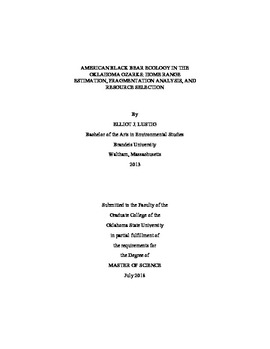| dc.contributor.advisor | Fairbanks, Wendelyn Sue | |
| dc.contributor.author | Lustig, Elliot J. | |
| dc.date.accessioned | 2019-03-20T19:10:02Z | |
| dc.date.available | 2019-03-20T19:10:02Z | |
| dc.date.issued | 2018-07-01 | |
| dc.identifier.uri | https://hdl.handle.net/11244/317628 | |
| dc.description.abstract | Black bears (Ursus americanus) were extirpated from Oklahoma in the late 19th century but have since recolonized eastern portions of the state after successful translocations in Arkansas. Within the last two decades, a population of black bears was detected in the Oklahoma Ozark region, prompting multiple demographic studies to determine population size, growth rate and genetic makeup. To understand how black bears were recolonizing the human-dominated landscape, we investigated individual home ranges, effects of fragmentation on male and female black bears and resource selection at two scales. | |
| dc.description.abstract | Between 2011 - 2016, GPS collar spatial data was collected for 23 individuals (10M, 13F). Average kernel density estimated home ranges were calculated on a seasonal scale for both males and females using ArcGIS 10.2 and Geospatial Modeling Environment. Based on 72 female home ranges (38 summer, 34 autumn) and 17 male home ranges (7 summer, 10 autumn), we determined that female home ranges were significantly smaller than male home ranges. Fragmentation analysis was conducted in FRAGSTATS v.4.2.1 on the landscape scale, using the edge density and contagion metrics. We found that females are sensitive to fragmentation whereas males are not. These results suggested that anthropogenic fragmentation may limit suitable areas for female home ranges, and therefore limit growth of this population. | |
| dc.description.abstract | Resource selection functions were calculated using R v.3.4.3 as generalized linear mixed models (GLMMs). Resource selection was calculated on the study area and home range scales, to understand detailed differences in selection. Black bears across seasons and scales selected riparian forest and moist oak forest land cover types while mostly selecting against indicators of human activity, such as the pasture/prairie and anthropogenic land cover types as well as roads and areas of high human population density. Black bears did not differ in selection by sex, although females were found to be further from roads than males, on average. Thus, areas and features characterized as human-altered may negatively impact black bear recolonization, especially the females. Further expansion of the species' distribution could be slowed or halted if female black bear movement is significantly impeded by anthropogenic disturbance in the region. | |
| dc.format | application/pdf | |
| dc.language | en_US | |
| dc.rights | Copyright is held by the author who has granted the Oklahoma State University Library the non-exclusive right to share this material in its institutional repository. Contact Digital Library Services at lib-dls@okstate.edu or 405-744-9161 for the permission policy on the use, reproduction or distribution of this material. | |
| dc.title | American Black Bear Ecology in the Oklahoma Ozarks: Home Range Estimation, Fragmentation Analysis, and Resource Selection | |
| dc.contributor.committeeMember | Luttbeg, Barney | |
| dc.contributor.committeeMember | Leslie, David M., Jr. | |
| osu.filename | Lustig_okstate_0664M_15825.pdf | |
| osu.accesstype | Open Access | |
| dc.description.department | Natural Resource Ecology and Management | |
| dc.type.genre | Thesis | |
| dc.type.material | text | |
